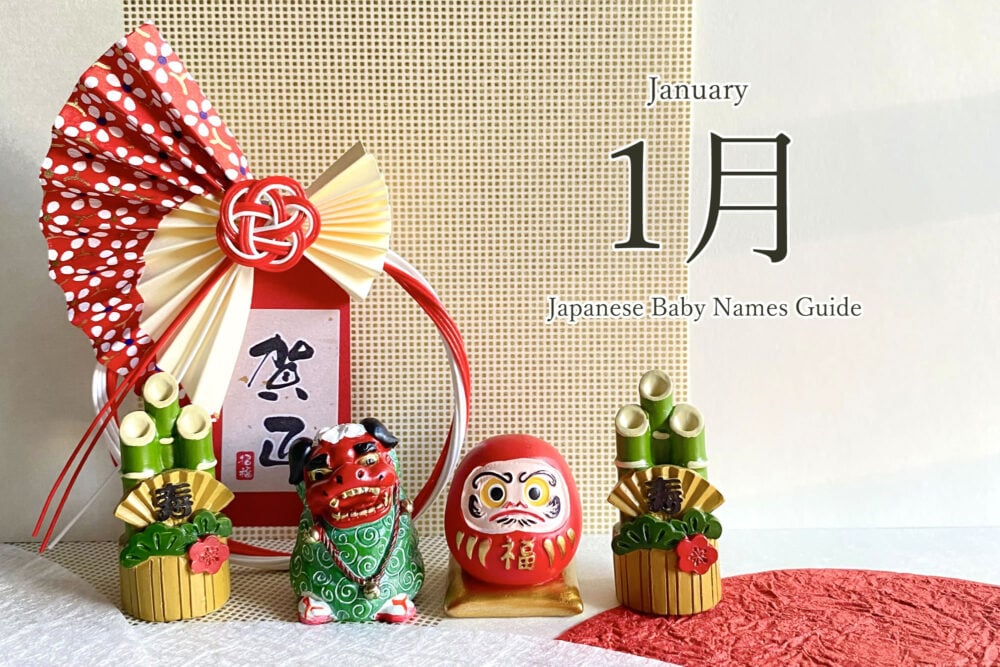Share on your favorite
Or copy the link
Below are navigation links that will take you to the main text and navigation menus.
26,551 first names, 70,620 last names, 333,585 kanji variations.
one of the best Japanese name search tools for your baby!

January in Japan is filled with the promise of new beginnings. From first shrine visits to the pristine imagery of winter’s snow, a baby born this month can carry the spirit of fresh starts and a clean slate. This article guides you through the special symbolism of a January birth, the seasonal elements that inspire parents, and how these motifs translate into kanji and names reflecting hope, clarity, and warmth during the coldest time of year.
Contents
In Japan, January marks the beginning of a new year and symbolizes a fresh start. Important traditions such as visiting a shrine or temple for “first prayers” (hatsumōde), watching the year’s first sunrise (hatsu-hinode), and many other New Year customs happen around this time. Because of this, a baby born in January often carries an extra sense of “new beginnings” and hope for the future.
January is the heart of winter in Japan. Snowy landscapes, crisp air, and winter-blooming flowers are common sights. Incorporating these winter images into a baby’s name can add a special, season-specific touch. In Japanese culture, names often include kanji (Chinese characters) that reflect nature or positive qualities the parents hope their child will embody.

oppo_0


In Japanese names, kanji convey specific meanings. The choice of each character—whether to represent winter imagery, a hopeful future, or positive traits—can have a big impact on the nuance of the name.
Below are examples of names that capture the spirit of January. Each name includes possible pronunciations (in parentheses) and a brief explanation of the meaning or imagery behind it. In Japanese, the same kanji can often be read in different ways, so these are just a few possibilities.
Japanese kanji can often have multiple readings. It’s wise to confirm that the chosen name is easy enough for others to pronounce and won’t cause confusion in daily life. If you plan to live or travel internationally, you may also consider how it sounds in English or other languages.
Some families consult fortune-telling or numerology systems (kazu or sūji) to see if the kanji combination has auspicious stroke counts. While not everyone in Japan follows this, it can be a way to gain family consensus or simply feel reassured about the name’s positive vibrations.
Names that heavily reflect the season are adorable for a newborn. However, consider how the child may feel as they grow into adulthood. Also think about future situations like school, work, and travel abroad—especially if the name has very specialized characters that are difficult to read or write.
In Japanese tradition, January is filled with the promise of a new year—fresh opportunities, good fortune, and a sparkling winter landscape. When you weave that symbolism into a baby’s name, you offer a deeply meaningful “first gift” that can stay with them throughout their life.
Whether you choose a name showcasing New Year’s optimism (using kanji like “新” or “初”) or one that highlights winter’s pristine charm (“雪,” “凜,” “澄”), the goal is to infuse it with love, hope, and positive energy. Take inspiration from these examples and tailor them to create a name that resonates with your family’s wishes for your new arrival.


Following our previous article on summer-themed Japanese names, we now turn to autumn—a season many Japanese consider the most artistic and reflective time of year. In Japan, nature’s colors transform in breathtaking ways, while cultural events celebrate both the harvest and creative pursuits. As with the other seasons, these autumnal qualities inspire parents to choose names that capture the essence of fall.
Sort by: Most Kanji Variations
Sorts names by how many different kanji spellings they have. In general, names with more variants tend to be more familiar and widespread in Japan (with some exceptions).
Sort by: Most Viewed
Sorts names by page views on this site. Views reflect global traffic (including Japan), so this does not represent popularity among Japanese people only. A high view count does not necessarily mean the name is famous in Japan.
What is Hiragana?
Hiragana is one of the two Japanese syllabaries. Each character represents a sound (mora), not a meaning. It is used for native words, grammatical particles, verb/adjective endings (okurigana), and to show pronunciation above kanji (furigana). It developed from cursive forms of kanji.
What is Katakana?
Katakana is one of the two Japanese syllabaries. Each character represents a sound (mora), not a meaning. It is mainly used to write foreign words and names, loanwords, onomatopoeia, and for emphasis.
What are English Syllables?
A syllable is a unit of pronunciation in English — it’s the beat you hear when you say a word.
Here are a few quick examples:
cat = 1 syllable
ba-by = 2 syllables
beau-ti-ful = 3 syllables
On this site, English Syllables show how a name naturally breaks into sounds when spoken in English. This helps you understand how English speakers naturally say the name and where they pause between sounds.
What are Japanese Morae?
A mora (plural: morae, Japanese: 拍 Haku) is the basic unit of sound in Japanese — think of it as one rhythmic “beat” when speaking.
Here are a few quick examples:
あ (a) = 1 mora
あい (a-i) = 2 morae
きょう (kyo-u) = 2 morae
On this site, Japanese Morae show how many “beats” a name has in Japanese. Most Japanese names have about 2–4 morae, which affects how natural and rhythmic the name sounds to native speakers.
This helps you see how the name fits into the natural rhythm of Japanese speech.
What is English Transcription?
“English transcription” (romanization) is the romanized form of a Japanese name, intended to reproduce its pronunciation as closely as possible. It is also useful for searching names on this site.
Japanese-Style Nicknames
In Japan, nicknames are used to express familiarity and affection. Typical features include:
Shortened forms: Names are often shortened for closeness, e.g., “Yuki” from “Yukiko” or “Taka” from “Takashi”.
Suffixes: Terms like “-chan” (often for girls, also for young children) and “-kun” (often for boys) are used among family and close friends. Among very close adults, “-chan” may still be used. More details
Use & context: Nicknames are informal—common among friends, family, or close colleagues—and are not suitable for formal or professional settings. Their use implies a certain degree of intimacy.
Long vowels: The long vowel mark “chōonpu” (ー) extends the preceding vowel. For example, “あーちゃん” (A-chan) lengthens the “あ” sound.
Households
Sorts surnames by the estimated number of Japanese households that use them. More households generally indicates a more common or well-known surname.
About our last-name data
